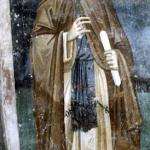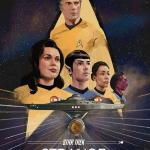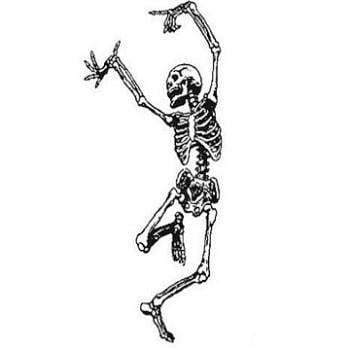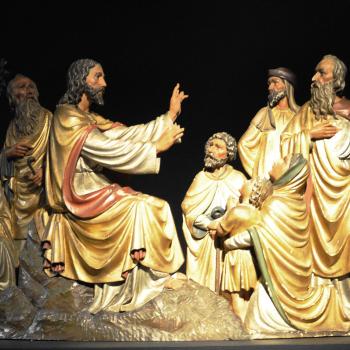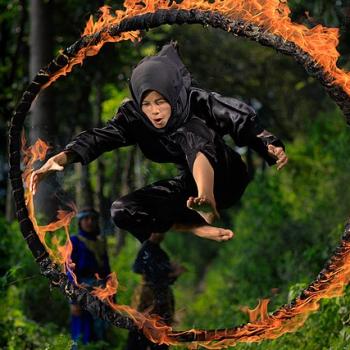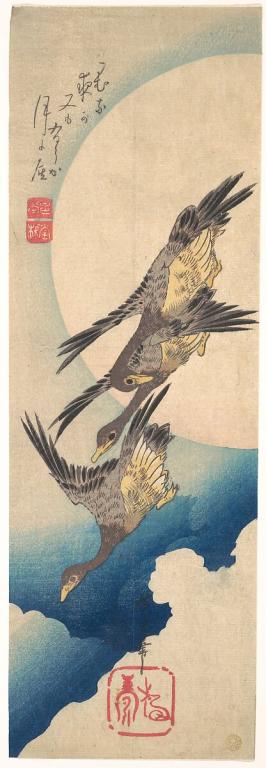
The living way is like a well:
You can constantly use it, and yet it never dries up.
It is the eternal boundlessness;
Birthing the infinite worlds.
It is hidden from sight and yet always present.
I have no idea who gave it birth.
It is older than God.
Tao Te Ching, Chapter 4
(my paraphrsase)
There are elements that we can discern as “religious-like” in some animal behaviors. Of course, there is nothing to suggest non-human animals believe in God or gods, or many of the other things one associates with religions, like praying, or worshiping. But they do do things that we associate with human religions.
For instance, many animals engage in ritual behaviors. Jane Goodall, as an example, observes how chimpanzees appear to dance when they come upon waterfalls and do something similar at the beginning of rainstorms. Many animals also appear to observe funeral rites. I watched a video clip of elephants doing what certainly looked like a ritual of mourning for one of their own.
One could say animals may not be religious, but some sure look to be spiritual.
For humans we see archeological evidences of similar behaviors as far back as maybe a hundred thousand years, with grave sites that include what are called “grave goods” such as tools and ornaments. And how in many places there is evidence that corpses were covered in flowers. This is true with both our main line of evolution and our closest cousins the Neanderthals. As an aside and as regards the other great interbreeding human population with our main line, the Denisovans. We just haven’t, so far, found much physical evidence of their cultures. But there is no compelling reason to assume they or the as yet unnamed but genetically identified fourth group of early interbreeding humans, did not also share these behaviors.
These spiritual if not quite yet religious behaviors can reasonably be assumed to be common to us all.
While there’s no evidence of belief in some idea of a supreme being before the rise of religions as we generally understand the term, there are strong suggestions of spiritualities as pretty basic to who we are as humans. By this I mean there seems to be some common sense among humans of mystery and connections that extend beyond our awareness of that harsh phenomenon of our being alive and knowing we will die.
It seems we can learn some very important things looking at hunter gatherer religious views. The nineteenth century anthropologist, Edward Tylor coined the term “animism” to address his observations. Specifically he noticed how hunter gatherer cultures pretty much across the globe everything is seen as animated. Everything possesses a spirit or spirit. Professor Tyler, the first professor of Anthropology at Oxford, thought animism was a confusion between animals and plants and inanimate things. He felt this weak sense of categories was an obviously mistaken view, but one common, it appears, to all early humans. And, as he saw it, this confusion of categories would also be a building block of later organized religions.
However, the term has been worked and reworked in the years following based upon further research as well as noting hidden biases in interpretation among those early Western ethnographers. Contemporary Anthropologist Nurit Bird-David speaks for a shift in interpretation, suggesting instead how animism is a “relational epistemology.” Epistemology is a five-dollar word meaning “how we know things.” So, an expensive term, but worth it. It calls us to notice such things as how we know things.
Specifically, animism is an approach to life that is centered in our relationships. It is a world filled with subjects rather than objects. Everything is relational. And it carries hints of some sense of radical interdependence. Here I believe we find the heart of the spiritual impulse. The animist approach of relationship is really rich.
With agriculture religious institutions began to emerge. Here we find, as with other agriculturally based cultures, the emergence of gods. Gods are nonhuman entities that have power, and with whom we humans interact. And from there, well…
I’m a fan of Gore Vidal’s historical novels. History as gossip. Of these my favorite is Creation. The novel opens with an aged Persian ambassador to Athens incensed as he hears Herodotus lecture on the Persian wars and decide to provide his own reminiscences of recent history, much of which he witnessed at first hand.
The putative author of these memoirs is the grandson of the prophet Zoroaster. Thanks to this privileged position, he found himself everywhere that counted in this amazing age. From when the story begins where he watches his young stonemason Socrates building a wall that keeps falling down, back to his time with the Buddha who would look right through him when they were talking, always preferring to gaze into the middle distance over making eye contact, to his time with what is obviously Vidal’s favorite character, Confucius. But as this is Vidal even this hero of mind and spirit has a face like a horse and a bad case of halitosis. That’s pure Gore Vidal and history as gossip.
This book is Vidal’s treatment of the Axial Age. That term, Axial Age comes from the philosopher Karl Jaspers’ 1949 study, Origin and Goal of History. Most of us, if we’ve heard the term Axial Age, can actually thank the independent scholar Karen Armstrong who made much of it in her History of God and then went on to a detailed reflection in the Great Transformation. It is Jasper’s, Armstrong’s, and truthfully, many scholars and philosophers and theologians view that there was a period roughly between the eighth and second centuries before our common era, where the world changed. Here the religions from the dawn of agriculture were distilled in a half dozen parts of the world, each in its own way offering insights into our human condition as communities and individuals. A fair amount of it crowd control. But not all of it.
In a time of darkness and violence at various places around the globe ranging from the Greek philosophers of the Mediterranean basin, into the Near East were various prophets began to proclaim visions of justice, to India where Mahavira and Gautama Siddhartha taught and to China where Confucius and Laotzu proclaimed new visions of life, what would become the world religions, or at least their ancestors most all emerged.
Armstrong presents a fascinating thesis. She says an ethical spirituality emerged in this Age. Articulated in many different ways, nonetheless containing some tangible commonalities. Among the most important was that summation of morality first articulated by the guy with bad breath, writing five hundred years before the birth of Jesus, ‘Do not do unto others as you would not have them do unto you.’ In Great Transformation Armstrong elaborates on her vision of that common thread she perceives, a sort of ethical mysticism.
That said there are real problems with this whole thesis of the Axial Age, which is seen as a profound advancement, an evolutionary leap over what was before. I feel some hesitation about how we know this. The textual data about what was going on before isn’t particularly helpful.
Mostly we get details of sacrificial practices, from which we derive a lot of suppositions, but little certainty about what they actually thought and felt. Although one thing we do get is that those so-called primal religions that in much of the world would soon be swept away tended to be pretty tolerant of each other.
Which just isn’t true for the Near Eastern religions such as Zoroastrianism, or the proto-religion, which would over time birth Judaism, Christianity and Islam. These were all religions that were pretty adamant they had a finger on the one true way, and so the adherents of these religions, as we know, have not tended to play well with others. That and the holding up of images of war and violence as sacred have had dire consequences for many people. There’s been lots of blood flowing from that particular Axial Age thesis, lots. And frankly not something I see as an advancement of the human condition.
The second difficulty is working up a realistic timeline. This whole Axial Age is one slippery concept. Christianity actually births two hundred years after most scholars would end the period, and Islam nearly seven centuries after that. With over three and a half billion adherents between them, that’s over half of humanity not actually heirs to this era. In addition contemporary scholarship seems to relentlessly push the life of the prophet Zoroaster ever earlier than had originally been thought. And Laotzu, if there ever was a Laotzu, I mean how many people name their child “old man,” turns out not to be a contemporary of Confucius, but a much later figure.
Vidal can get away with his timeline, he’s just writing a novel. But for a historical religious investigation, well, it’s stuck with the moving and mutable target called history. And history isn’t particularly kind to the idea of an Axial Age. There’s something there, but how much is very much an open question.
But, most important, much is made of the assertion that in this Axial Age, there was a shift in perspective from animisms of several sorts to a realization of the importance of the individual. To be clear the shape of the human mind finds its origins much, much earlier. The little bands Anthropologists call Homo sapiens sapiens who arose in Africa and some of whom left to populate much of the world, living long before the rise of the Axial Age cultures were fully human. And by definition, these humans were fully capable of knowing their individuality as well as their radical dependence upon each other.
And at the same time we’re creatures of culture. We live and breathe and take our being within our cultures. We’re dependent upon our cultures in ways we almost never know. They protect us, and in some ways, they imprison us. And our religions are intimately bound up as part of this project.
That said, with hesitation and qualifications, we appear to be at the dawn of a new shift. Something as great as the dawn of animism. Something as great as the dawn of religions. Something as profound as the Axial age.
It is happening around the globe, but mostly within the confines of the Global North. Most definitions acknowledge “north” is a placeholder as the countries range from almost all European countries, Israel, Cyprus, Japan, Singapore, South Korea, Taiwan, Australia, New Zealand, Canada, and the United States. We also see aspects of it in perhaps all the mega cities of the world. And that is the collapsing of institutional religions. Whether a resetting or an actual collapse is not clear. And it isn’t happening evenly across the Global North. It began hard in Europe and is quickly happening in Japan, Canada, and the United States.
Some major disruption of the place of religions.
It is going in a number of ways, but the people I find most interesting are the spiritual but not religious.
Is something new emerging? A sense of the sacred disconnected from the major religious project for all of history, social cohesion? Maybe, not so much a return, but a going forward toward a new animism, a new universalism.
It’s hard to say. Those hesitations. Those qualifications.
At its worst, well, it can be pretty bad. As the Unitarian Universalist theologian James Luther Adams once observed, “Nothing sells like egoism wrapped in idealism.” At its best I see hearts turning toward mutual subjectivity, a broad and heartful universalism.
I’m feeling we may even be at the dawn of something wonderful. In the midst of the hard times, of climate change and natural disaster, at the edge of major population shifts, at a time when democracies are considering surrendering to autocrats around the globe, a seed is sprouting.
And I am hopeful.



